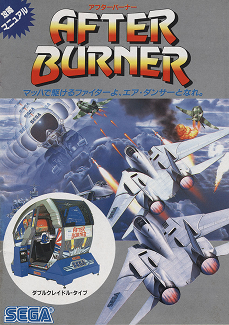After Burner
| After Burner | |
|---|---|

Japanese arcade flyer of After Burner.
|
|
| Developer(s) | Sega AM2 |
| Publisher(s) | Sega |
| Designer(s) | Yu Suzuki |
| Composer(s) |
Hiroshi Kawaguchi Jeroen Tel (Commodore 64 US version) Adam Gilmore (Commodore 64 EU version) |
| Platform(s) | Arcade, Amiga, Amstrad CPC, Atari ST, Commodore 64, MS-DOS, MSX, Nintendo Famicom/Entertainment System, PC Engine, Sega 32X, Sega Master System, ZX Spectrum |
| Release |
Arcade
|
| Genre(s) |
Combat flight simulator Shoot 'em up |
| Mode(s) | Single-player |
| Cabinet | Upright, sit-down cockpit |
| Arcade system | Sega X Board |
| Display | Raster |
After Burner (アフターバーナー Afutā Bānā?) is a 1987 combat flight simulator arcade game designed by Yu Suzuki for Sega AM2. The player flies an F-14 (with moving seat, in some installations) using a specialized joystick. The game spawned several sequels.
The game allows the player to control a F-14 Tomcat jet, which must destroy a series of enemy jets throughout 18 stages. At the start of the game, the player takes off from an aircraft carrier called the SEGA Enterprise, which shares a similar name to the one used in the 1986 film Top Gun.
In the arcade version, the jet itself employs a machine gun and a limited set of heat-seeking missiles, in the Mastersystem version there is an unlimted amount of missiles. These weapons are replenished by another aircraft after beating a few stages. The aircraft, cannon and missile buttons are all controlled from an integrated flight stick.
The game itself was released in two variations: a standard upright cabinet and a rotating cockpit version. In the cockpit version, the seat rotated horizontally, and the cockpit rotated vertically. The rotating cockpit version also featured two speakers inside the cockpit at head-level, which produced excellent stereo sound that significantly added to the gameplay experience. Both cabinets contained a grey monitor frame with flashing lights at the top that indicated an enemy's "lock" on your craft.
Computer Gaming World called After Burner on the console "the first game that uses Sega's new 4MB technology and the enhanced graphic capabilities this added memory provides is abundantly obvious". It cited aircraft depicted in "remarkable detail", "spectacular" scenery, and excellent explosions. A later review on the computer was much more critical, giving the game one star out of five and stating that it was inferior to the arcade version.
...
Wikipedia
